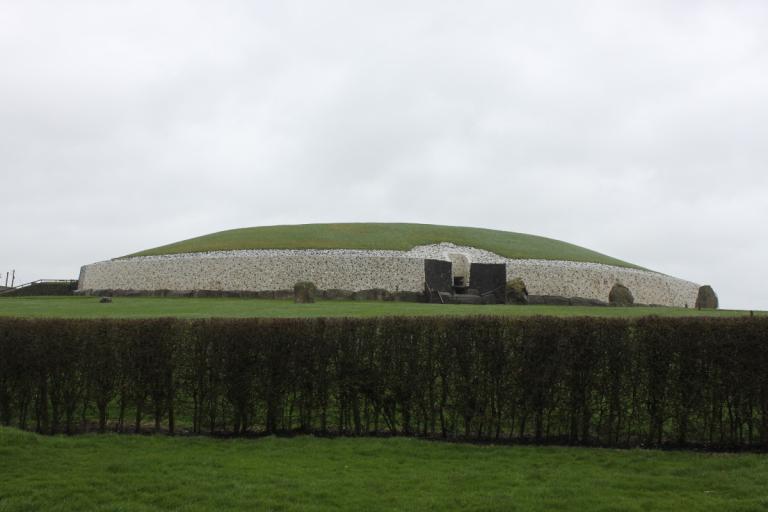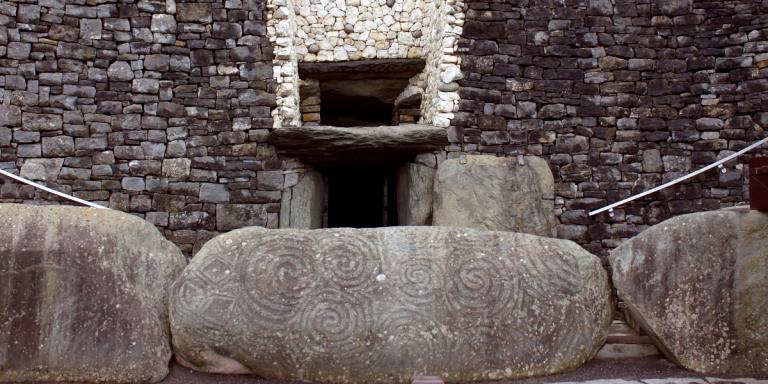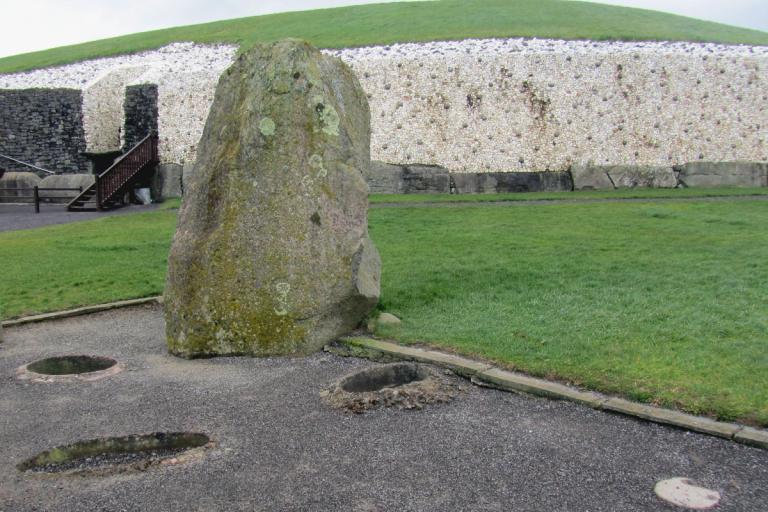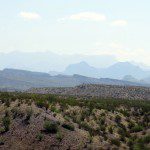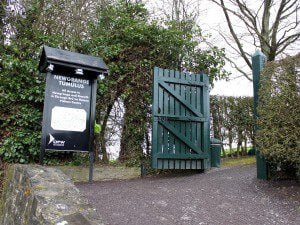 The Winter Solstice brings some Neolithic magic to the 5200-year-old mound of Newgrange in Ireland.
The Winter Solstice brings some Neolithic magic to the 5200-year-old mound of Newgrange in Ireland.
On the three days surrounding the Winter Solstice, light from the rising sun enters the roof box over the entrance, moves down the passageway, and illuminates the carvings on the stones on the rear of the tomb – along with anything placed in the basin stone in front of the carvings. After a few minutes the sun rises further and the light begins to retreat down the passageway. Seventeen minutes after it all began, the tomb is once again plunged into darkness.
Each year, about 30,000 people enter a drawing to be inside Newgrange on one of the three days of the Winter Solstice. 50 are chosen, and many years clouds obscure the sunrise. For a first-hand account of what this experience is like, see this Wild Hunt essay from Rhyd Wildermuth, who was inside last year.
The name Newgrange means “new farm” – the name was given to the area by Cistercian monks in the Middle Ages to differentiate it from their old farms. If the ancients had a name for this monument it is lost forever.
We don’t know with certainty why Newgrange was built or how it was used. We know it served as a tomb, but we also know it was not a final resting place. Human remains were brought in, and after some time they were taken out. Although it may have been a temple, there is no evidence of daily or weekly activity at any point.
In his book Pagan Britain, history professor Ronald Hutton calls mounds like Newgrange “tomb-shrines.” Hutton says this term “recognizes the presence of the dead at most of these monuments, but also the equally apparent fact that the structures were not simply receptacles for them, but functioned as sites of ritual in their own right.”
We cannot know what those rituals were. Perhaps they were large community rituals led by an elder or a priest (but not a Druid – they didn’t appear till centuries after the tomb-shrines had fallen into disuse). Perhaps they were solitary observances, with individuals taking turns entering the tomb for private communion with the ancestors. We don’t know. We do know that extraordinary effort went into building and maintaining Newgrange, and that people would not have done so unless they had a very good reason for it – unless the experiences Newgrange facilitated were meaningful enough to justify the great expense of time and energy.
But one year, people simply stopped coming. Again, we don’t know why. Perhaps a changing climate or invading tribes forced the people to move. Perhaps beliefs about tomb-shrines changed. We don’t know. What we do know is that no living human entered the tomb for around 3500 years, until it was rediscovered in 1699. The roof box and the magic of the Winter Solstice sunrise weren’t rediscovered until 1967.
While we cannot know the ceremonies that took place at Newgrange, it’s not hard to guess their general intent, particularly if you have been inside Newgrange and other tomb-shrines. Even after thousands of years the presence of the ancestors is strong inside them. Perhaps that presence is physical, perhaps it is spiritual, and perhaps it is psychological. One explanation that seems especially likely is that those in the community who died during the year were placed in the tomb. On the Winter Solstice, the sunlight illuminated the remains, which sent the dead on to the Otherworld. Then the remains were removed and buried elsewhere.
If Newgrange and the other tomb-shrines are to have meaning for us beyond historical curiosity, it will not be in deciphering why they were built or how they were used. Rather, their meaning for us lies in how they move us to do now what the ancient Irish did then: to celebrate the Solstice, and to honor our ancestors.
The Winter Solstice is likely humanity’s oldest holy day. As the days shorten and the temperatures fall, Nature whispers a truth: Winter is coming. For those who live in northern latitudes and higher elevations, it’s already here. And it’s going to get worse, even here in Texas. What better time for us to come together and enjoy food and drink and to focus our attention on our families, our religious communities, and our most sacred traditions.
Perhaps the candles we light at the many Christmas and Hanukkah and Yule celebrations are acts of sympathetic magic to help bring about the return of the light. Or perhaps they’re reminders that the light will return, because it always has. In any case, after the Winter Solstice, the days begin to lengthen, and the sun begins to move northward again. The worst of the cold is yet to come, but Spring will return. The Winter Solstice reminds us to have hope, and it reminds us that at least some things that die are reborn. It is no wonder many Gods and heroes are said to have been born at this time. If all religion suddenly disappeared from the Earth, people would be celebrating the Winter Solstice again within a generation.
Today, we still know no more about what comes after death than our ancestors who built Newgrange over 5000 years ago. Our obsession with our individual identity often causes us to forget what they knew: when we honor our ancestors, they live on. And when we build a tradition of honoring ancestors, we insure that we ourselves will live on in the memories, stories, and rituals of those who come after us.
So let us light our candles, decorate our trees, and prepare our special foods. Let us renew the bonds of kinship and of friendship. And as the Winter Solstice sunrise illuminates the interior of Newgrange, the rising sun will illuminate the bones of our beloved dead, for the spiritual sun is never obscured by clouds. They will move on to the land of the Gods and ancestors, where ever that is, what ever that is.
It is left to us to remember them, to honor them, and to build a foundation for the next generation that is even stronger than the one left for us. For we know little about what comes after death, but we know that some day we will become ancestors, and those who remain will remember us.
May we live our lives so as to be worthy of their honor.


